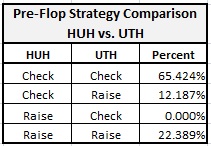Heads-Up Hold'em (HUH) is a novelty game with rules very similar to Ultimate Texas Hold'em (UTH) (see this post and this post). There are three differences: (1) HUH only allows a 3x pre-Flop raise; (2) the Blind bet is called the "Odds" bet; and (3) the Odds bet also pays when the player's hand is a straight or higher and loses. Because of their similarity, they have the same physical vulnerabilities to hole-card play. However, because HUH only allows a 3x pre-Flop raise, those situations when the player sits very strong against the dealer cannot be leveraged as much pre-Flop. For this reason, I expected going into this analysis that the edge for seeing one dealer hole-card in HUH would be slightly less than that for UTH.
Getting right to the point, here are the statistics for computer-perfect play in the situation when the AP can see one dealer hole-card:
- The player edge in HUH knowing one dealer hole-card is 12.6014%.
- The player makes a 3x pre-Flop raise on 22.3891% of his hands.
- The player checks pre-Flop on 77.6109% of his hands.
By comparison, the edge for computer-perfect hole-card play against UTH is 13.4316% (see this post).
My program considered equivalence classes of starting hands so that not every possible starting hand was evaluated. For example, if the player has (2c, Ad) and the dealer has Jd, that is clearly the same as the player having (2d, Ah) and the dealer having Jh. Similarly, player = (3c, 3d), dealer = 7c is the same as player = (3c, 3d), dealer = 7d. Altogether there were 5083 equivalence classes. In the spreadsheet there is a column called "Perms" that lists the number of starting hands that are equivalent to the given sample hand from its equivalence class.
Here is the spreadsheet that gives the output produced by my program. This output includes the entire pre-Flop strategy for HUH. For reference, I also included the pre-Flop strategy for UTH and color-coded the differences between the strategies:
HUH_DHC_Computer_Perfect_Strategy
The following table summarizes the differences in pre-Flop hole-card strategy between HUH and UTH:

In particular, every time the AP raises 3x pre-Flop in HUH, then he would also raise 4x in UTH in a similar situation. In other words, checking in UTH implies checking in HUH.
The following spread sheet lists the 1190 distinct starting hands consisting of two player cards and dealer hole-card, where the AP raises 3x pre-Flop:
HUH_DHC_Computer_Perfect_Strategy_Raise
Writing out complete rules for pre-Flop hole-card strategy for HUH is not too tough, but is an exercise I don't want to undertake in full. Here is the "Pairs" part of pre-Flop raising strategy:
- If the pair is 2-2 through 9-9, then only raise if the dealer's hole-card is of equal rank or less than the pair. For example, raise 3x pre-Flop holding 4-4 vs. a dealer 2, 3 or 4, otherwise check.
- If the pair is T-T through A-A, then always raise 3x pre-Flop.
Another easy rule:
- Check all non-pairs if the higher ranking card is 9 or less.
And so on ...
As far as the Flop and Turn/River strategies. I am sure that Grosjean's UTH strategy will work just fine (time for you to buy a copy of Exhibit CAA from your local bookstore), with the exception that the player never folds a made straight or higher.
As far as game protection, HUH is obviously an extremely vulnerable game, I recommend that HUH be hand dealt, using the following procedure:
- After removing the cards from the automatic shuffler, and after each player has made their Ante bet, a card is burned and two cards are dealt face-down to each player.
- The players then look at their cards and make their pre-Flop check/raise decisions.
- Another card is burned, then three Flop cards are dealt and turned face-up.
- The players who have not yet raised then make their Flop check/raise decisions.
- Another card is burned, then two Turn/River cards are dealt and turned face-up.
- The players who have not yet raised then make their Turn/River raise/fold decisions.
- Another card is burned, then two cards are dealt to the dealer and turned face-up.
- All necessary cards have now been dealt, and the wagers can be resolved.
By avoiding dealing cards until those cards are necessary for the next wagering step in the game, there will be no hole-card opportunities. By burning the top card before cards are dealt, there will be no top-card (or marked-card) opportunities. This method of dealing HUH is the same as that used for UTH throughout Las Vegas.


